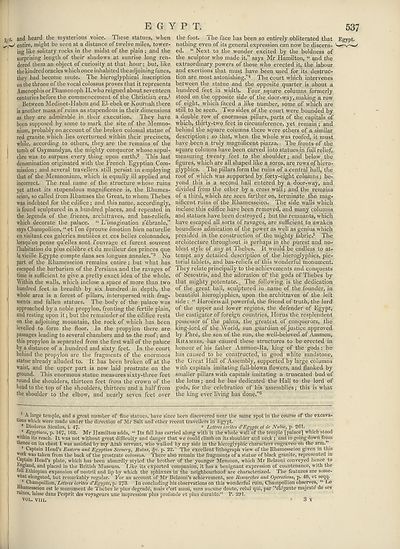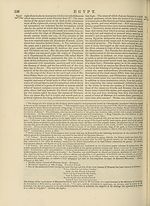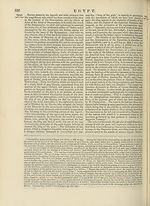Encyclopaedia Britannica > Volume 8, DIA-England
(547) Page 537
Download files
Complete book:
Individual page:
Thumbnail gallery: Grid view | List view

E G Y P T. 537
r, )t. and heard the mysterious voice. These statues, when
entire, might be seen at a distance of twelve miles, tower¬
ing like solitary rocks in the midst of the plain ; and the
surprising length of their shadows at sunrise long ren¬
dered them an object of curiosity at that hour; but, like
the kindred oracles which once inhabited the adjoining fanes,
they had become mute. The hieroglyphical inscription
on the throne of the vocal colossus proves that it represents
Amenophis or Phamenoph II. who reigned about seventeen
centuries before the commencement of the Christian era.1
Between Medinet-Habou and El-ebek or Kournah there
is another mass of ruins as stupendous in their dimensions
as they are admirable in their execution. They have
been supposed by some to mark the site of the Memno-
nium, probably on account of the broken colossal statue of
red granite which lies overturned within their precincts,
while, according to others, they are the remains of the
tomb of Osymandyas, the mighty conqueror whose sepul¬
chre was to surpass every thing upon earth.2 This last
denomination originated with the French Egyptian Com¬
mission; and several travellers still persist in employing
that of the Memnonium, which is equally ill applied and
incorrect. The real name of the structure whose ruins
yet attest its stupendous magnificence is, the Ilhames-
seion, so called from Ilhamses the Great, to whom Thebes
was indebted for the edifice ; and this name, accordingly,
is found sculptured in a hundred places, and repeated in
the legends of the friezes, architraves, and bas-reliefs,
which decorate the palace. “ L’imagination s’ebranle,”
says Champollion, “ et Ton eprouve emotion bien naturelle
en visitant ces galeries mutilees et ces belles colonnades,
lorsqu’on pense qu’elles sont 1’ouvrage et furent souvent
1’habitation du plus celebre et du meilleur des princes que
la vieille Egypte compte dans ses longues annales.”3 No
part of the Ilhamesseion remains entire ; but what has
escaped the barbarism of the Persians and the ravages of
time is sufficient to give a pretty exact idea of the whole.
Within the walls, which inclose a space of more than two
hundred feet in breadth by six hundred in depth, the
whole area is a forest of pillars, interspersed with frag¬
ments and fallen statues. The body of the palace was
approached by a noble propylon, fronting the fertile plain,
and resting upon it; but the remainder of the edifice rests
on the adjoining mountain, the rock of which has been
levelled to form the floor. In the propylon there are
passages leading to several chambers and to the roof; and
this propylon is separated from the first wall of the palace
by a distance of a hundred and sixty feet. In the court
behind the propylon are the fragments of the enormous
statue already alluded to. It has been broken off at the
waist, and the upper part is now laid prostrate on the
ground. This enormous statue measures sixty-three feet
round the shoulders, thirteen feet from the crown of the
head to the top of the shoulders, thirteen and a half from
the shoulder to the elbow, and nearly seven feet over
the foot. The face has been so entirely obliterated that Egypt,
nothing even of its general expression can now be discern-
ed. “ Next to the wonder excited by the boldness of
the sculptor who made it,” says Mr Hamilton, “ and the
extraordinary powers of those who erected it, the labour
and exertions that must have been used for its destruc¬
tion are most astonishing.”4 The court which intervenes
between the statue and the opposite quarter is about a
hundred feet in width. Four square columns formerly
stood on the opposite side of the door-way, making a row
of eight, which faced a like number, some of which are
still to be seen. Two sides of the court were bounded by
a double row of enormous pillars, parts of the capitals of
which, thirty-two feet in circumference, yet remain ; and
behind the square columns there were others of a similar
description; so that, when the whole was roofed, it must
have been a truly magnificent piazza. The fronts of the
square columns have been carved into statues in full relief,
measuring twenty feet to the shoulder; and below the
figures, which are all shaped like a soros, are rows of hiero¬
glyphics. The pillars form the ruins of a central hall, the
roof of which was supported by forty-eight columns; be¬
yond this is a second hall entered by a door-way, and
divided from the other by a cross wall; and the remains
of a third, which are seen farther on, terminate the mag¬
nificent ruins of the Ilhamesseion. The side walls which
inclose this edifice have been removed, and many columns
and statues have been destroyed ; but the remnants, which
have escaped all sorts of ravages, are sufficient to awaken
boundless admiration of the power as well as genius which
presided in the construction of the mighty fabric.5 The
architecture throughout is perhaps in the purest and no¬
blest style of any at Thebes. It would be endless to at¬
tempt any detailed description of the hieroglyphics, pic¬
torial tablets, and bas-reliefs of this wonderful monument.
They relate principally to the achievements and conquests
of Sesostris, and the adoration of the gods of Thebes by
that mighty potentate. The following is the dedication
of the great hall, sculptured in name of the founder, in
beautiful hieroglyphics, upon the architraves of the left
side : “ Haroerisall powerful, the friend of truth, the lord
of the upper and lower regions, the defender of Egypt,
the castigator of foreign countries, Horus the resplendent
possessor of the palms, the greatest of conquerors, the
king-lord of the World, sun guardian of justice approved
by Phre, the son of the sun, the well-beloved of Ammon,
iiiiAMSEs, has caused these structures to be erected in
honour of his father Ammon-Ila, king of the gods: he
has caused to be constructed, in good white sandstone,
the Great Hall of Assembly, supported by large columns
with capitals imitating full-blown flowers, and flanked by
smaller pillars with capitals imitating a truncated bud of
the lotus; and he has dedicated the Hall to the lord of
gods, for the celebration of his assemblies; this is what
the king ever living has done.”6
1 A large temple, and a great number of fine statues, have since been discovered near the same spot in the course of the excava¬
tions which were made under the direction of Mr Salt and other recent travellers in Egypt.
’ Diodorus Siculus, i. 47. 3 Lettres ecritcs d'Egypte et de JYubie, p- 261.
* Egyptiaca, p. 167, 168. Mr Hamilton adds, “ Its fall has carried along with it the whole wall of the temple [palace] which stood
within its reach. It was not without great difficulty and danger that we could climb on its shoulder and neck ; and in going down from
thence on its chest 1 was assisted by my Arab servant, who walked by my side in the hieroglyphic characters engraven on the arm.”
s Captain Head’s Eastern and Egyptian Scenery, Ruins, <§c. p. 22. The excellent lithograph view of the Ilhamesseion given in this
work was taken from the back of the prostrate colossus. There also remain the fragments of a statue of black granite, represented in
Captain Head’s plate, which has been absurdly styled the brother of the younger Memnon, which Mr Belzoni conveyed hence to
England, and placed in the British Museum. Hike its exported companion, it has a benignant expression of countenance, with the
lull Ethiopian expansion of nostril and lip by which the sphinxes in the neighbourhood are characterized. The features are some¬
what elongated, but remarkably regular. For an account of Mr Belzoni’s achievement, see Researches and Operations, p. 40, et seqq.
* Champollion, Lettres ecrites d'Egyptc, p. 273. In concluding his observations on this wonderful ruin, Champollion observes, “ He
Ilhamesseion est le monument de Thebes le plus degrade, mais e’est aussi, sans aucune doute, celui qui, par ’’dlegante majesty de ses
nunes, laisse dans 1’esprit des vovageurs une impression plus profonde et plus durable.” P. 291.
VOL. Vin. ' » 3 Y
r, )t. and heard the mysterious voice. These statues, when
entire, might be seen at a distance of twelve miles, tower¬
ing like solitary rocks in the midst of the plain ; and the
surprising length of their shadows at sunrise long ren¬
dered them an object of curiosity at that hour; but, like
the kindred oracles which once inhabited the adjoining fanes,
they had become mute. The hieroglyphical inscription
on the throne of the vocal colossus proves that it represents
Amenophis or Phamenoph II. who reigned about seventeen
centuries before the commencement of the Christian era.1
Between Medinet-Habou and El-ebek or Kournah there
is another mass of ruins as stupendous in their dimensions
as they are admirable in their execution. They have
been supposed by some to mark the site of the Memno-
nium, probably on account of the broken colossal statue of
red granite which lies overturned within their precincts,
while, according to others, they are the remains of the
tomb of Osymandyas, the mighty conqueror whose sepul¬
chre was to surpass every thing upon earth.2 This last
denomination originated with the French Egyptian Com¬
mission; and several travellers still persist in employing
that of the Memnonium, which is equally ill applied and
incorrect. The real name of the structure whose ruins
yet attest its stupendous magnificence is, the Ilhames-
seion, so called from Ilhamses the Great, to whom Thebes
was indebted for the edifice ; and this name, accordingly,
is found sculptured in a hundred places, and repeated in
the legends of the friezes, architraves, and bas-reliefs,
which decorate the palace. “ L’imagination s’ebranle,”
says Champollion, “ et Ton eprouve emotion bien naturelle
en visitant ces galeries mutilees et ces belles colonnades,
lorsqu’on pense qu’elles sont 1’ouvrage et furent souvent
1’habitation du plus celebre et du meilleur des princes que
la vieille Egypte compte dans ses longues annales.”3 No
part of the Ilhamesseion remains entire ; but what has
escaped the barbarism of the Persians and the ravages of
time is sufficient to give a pretty exact idea of the whole.
Within the walls, which inclose a space of more than two
hundred feet in breadth by six hundred in depth, the
whole area is a forest of pillars, interspersed with frag¬
ments and fallen statues. The body of the palace was
approached by a noble propylon, fronting the fertile plain,
and resting upon it; but the remainder of the edifice rests
on the adjoining mountain, the rock of which has been
levelled to form the floor. In the propylon there are
passages leading to several chambers and to the roof; and
this propylon is separated from the first wall of the palace
by a distance of a hundred and sixty feet. In the court
behind the propylon are the fragments of the enormous
statue already alluded to. It has been broken off at the
waist, and the upper part is now laid prostrate on the
ground. This enormous statue measures sixty-three feet
round the shoulders, thirteen feet from the crown of the
head to the top of the shoulders, thirteen and a half from
the shoulder to the elbow, and nearly seven feet over
the foot. The face has been so entirely obliterated that Egypt,
nothing even of its general expression can now be discern-
ed. “ Next to the wonder excited by the boldness of
the sculptor who made it,” says Mr Hamilton, “ and the
extraordinary powers of those who erected it, the labour
and exertions that must have been used for its destruc¬
tion are most astonishing.”4 The court which intervenes
between the statue and the opposite quarter is about a
hundred feet in width. Four square columns formerly
stood on the opposite side of the door-way, making a row
of eight, which faced a like number, some of which are
still to be seen. Two sides of the court were bounded by
a double row of enormous pillars, parts of the capitals of
which, thirty-two feet in circumference, yet remain ; and
behind the square columns there were others of a similar
description; so that, when the whole was roofed, it must
have been a truly magnificent piazza. The fronts of the
square columns have been carved into statues in full relief,
measuring twenty feet to the shoulder; and below the
figures, which are all shaped like a soros, are rows of hiero¬
glyphics. The pillars form the ruins of a central hall, the
roof of which was supported by forty-eight columns; be¬
yond this is a second hall entered by a door-way, and
divided from the other by a cross wall; and the remains
of a third, which are seen farther on, terminate the mag¬
nificent ruins of the Ilhamesseion. The side walls which
inclose this edifice have been removed, and many columns
and statues have been destroyed ; but the remnants, which
have escaped all sorts of ravages, are sufficient to awaken
boundless admiration of the power as well as genius which
presided in the construction of the mighty fabric.5 The
architecture throughout is perhaps in the purest and no¬
blest style of any at Thebes. It would be endless to at¬
tempt any detailed description of the hieroglyphics, pic¬
torial tablets, and bas-reliefs of this wonderful monument.
They relate principally to the achievements and conquests
of Sesostris, and the adoration of the gods of Thebes by
that mighty potentate. The following is the dedication
of the great hall, sculptured in name of the founder, in
beautiful hieroglyphics, upon the architraves of the left
side : “ Haroerisall powerful, the friend of truth, the lord
of the upper and lower regions, the defender of Egypt,
the castigator of foreign countries, Horus the resplendent
possessor of the palms, the greatest of conquerors, the
king-lord of the World, sun guardian of justice approved
by Phre, the son of the sun, the well-beloved of Ammon,
iiiiAMSEs, has caused these structures to be erected in
honour of his father Ammon-Ila, king of the gods: he
has caused to be constructed, in good white sandstone,
the Great Hall of Assembly, supported by large columns
with capitals imitating full-blown flowers, and flanked by
smaller pillars with capitals imitating a truncated bud of
the lotus; and he has dedicated the Hall to the lord of
gods, for the celebration of his assemblies; this is what
the king ever living has done.”6
1 A large temple, and a great number of fine statues, have since been discovered near the same spot in the course of the excava¬
tions which were made under the direction of Mr Salt and other recent travellers in Egypt.
’ Diodorus Siculus, i. 47. 3 Lettres ecritcs d'Egypte et de JYubie, p- 261.
* Egyptiaca, p. 167, 168. Mr Hamilton adds, “ Its fall has carried along with it the whole wall of the temple [palace] which stood
within its reach. It was not without great difficulty and danger that we could climb on its shoulder and neck ; and in going down from
thence on its chest 1 was assisted by my Arab servant, who walked by my side in the hieroglyphic characters engraven on the arm.”
s Captain Head’s Eastern and Egyptian Scenery, Ruins, <§c. p. 22. The excellent lithograph view of the Ilhamesseion given in this
work was taken from the back of the prostrate colossus. There also remain the fragments of a statue of black granite, represented in
Captain Head’s plate, which has been absurdly styled the brother of the younger Memnon, which Mr Belzoni conveyed hence to
England, and placed in the British Museum. Hike its exported companion, it has a benignant expression of countenance, with the
lull Ethiopian expansion of nostril and lip by which the sphinxes in the neighbourhood are characterized. The features are some¬
what elongated, but remarkably regular. For an account of Mr Belzoni’s achievement, see Researches and Operations, p. 40, et seqq.
* Champollion, Lettres ecrites d'Egyptc, p. 273. In concluding his observations on this wonderful ruin, Champollion observes, “ He
Ilhamesseion est le monument de Thebes le plus degrade, mais e’est aussi, sans aucune doute, celui qui, par ’’dlegante majesty de ses
nunes, laisse dans 1’esprit des vovageurs une impression plus profonde et plus durable.” P. 291.
VOL. Vin. ' » 3 Y
Set display mode to:
![]() Universal Viewer |
Universal Viewer | ![]() Mirador |
Large image | Transcription
Mirador |
Large image | Transcription
Images and transcriptions on this page, including medium image downloads, may be used under the Creative Commons Attribution 4.0 International Licence unless otherwise stated. ![]()
| Encyclopaedia Britannica > Encyclopaedia Britannica > Volume 8, DIA-England > (547) Page 537 |
|---|
| Permanent URL | https://digital.nls.uk/193330116 |
|---|
| Attribution and copyright: |
|
|---|
| Description | Ten editions of 'Encyclopaedia Britannica', issued from 1768-1903, in 231 volumes. Originally issued in 100 weekly parts (3 volumes) between 1768 and 1771 by publishers: Colin Macfarquhar and Andrew Bell (Edinburgh); editor: William Smellie: engraver: Andrew Bell. Expanded editions in the 19th century featured more volumes and contributions from leading experts in their fields. Managed and published in Edinburgh up to the 9th edition (25 volumes, from 1875-1889); the 10th edition (1902-1903) re-issued the 9th edition, with 11 supplementary volumes. |
|---|---|
| Additional NLS resources: |
|

